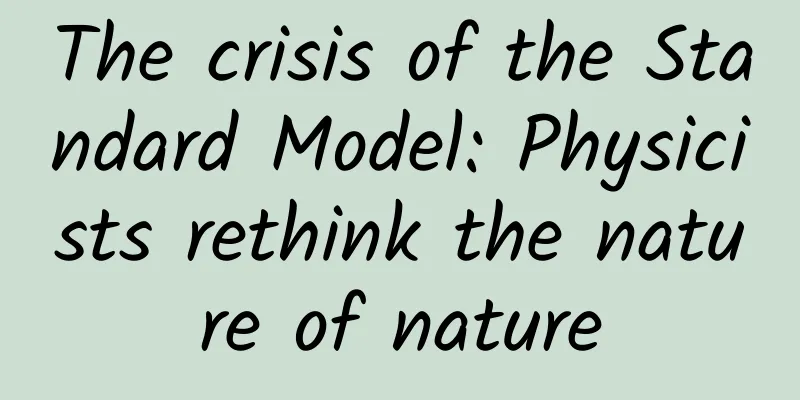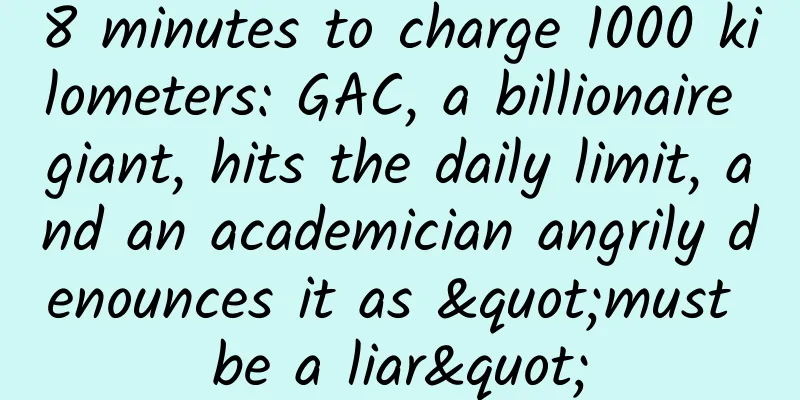The crisis of the Standard Model: Physicists rethink the nature of nature

|
Although the Standard Model is considered one of the most successful physics theories of all time, in recent years there have been more and more signs suggesting that the Standard Model is in crisis. In fact, the Standard Model has not been perfect since its birth, and it is not even a self-consistent theory. It is "unnatural", especially the "hierarchy problem" caused by the mass of the Higgs boson, which has no fundamental answer so far. There is a simple and convenient theory to explain these problems, namely the supersymmetry theory, but in terms of experiments, the most powerful collider has not found any supersymmetric particles so far. This has forced many physicists to rethink the nature of the model. Perhaps at the most basic level, reductionist thinking cannot solve the problem, even though this idea has been leading the development of physics for the past few hundred years. Now, many physicists have found a "mixed" mode of different energy scales to solve the "naturalness" problem, breaking the original form of reductionism. By Natalie Wolchover Translation | Liu Hang For nearly three decades, scientists have been searching in vain for new fundamental particles that could explain the nature we observe. As physicists face failure in their search for new particles, they have been forced to rethink a long-standing assumption: that big things are made of small things. Emily Buder/Quanta Magazine; Kristina Armitage and Rui Braz for Quanta Magazine [Please go to the "Fanpu" official account to watch the video] In his classic work, The Structure of Scientific Revolutions, philosopher of science Thomas Kuhn observed that scientists sometimes take a long time to make small steps. They pose a difficult problem and synthesize all the data to solve it within a fixed worldview or theoretical framework, which Kuhn called a paradigm. Sooner or later, however, facts that conflict with the prevailing paradigm suddenly emerge. A crisis ensues. Scientists rack their brains, reexamine their assumptions, and eventually make a revolutionary shift toward a new paradigm, a fundamentally different and more realistic understanding of nature. Then the steady progress of science begins again. For years, particle physicists who study nature's most fundamental building blocks have been in the grip of this textbook Kuhn crisis. The crisis became undeniable in 2016. Despite a major upgrade at the time, the Large Hadron Collider (LHC) in Geneva had still not “summoned” any new elementary particles—something theorists had expected for decades. The extra swarm of particles would primarily solve a puzzle about a known particle, the famous Higgs boson. That puzzle is called the hierarchy problem, “why is the Higgs so light”—1017 times smaller than the highest energy scales that exist in nature. Compared to those higher energies, the Higgs’s mass seems unnaturally small, as if the huge numbers in the fundamental equations that determine its value have miraculously canceled out. The extra particles could explain why the Higgs' mass is so tiny (relative to the Planck scale), restoring what physicists call "naturalness" to their equations. But they haven't found them since the LHC became the third and largest collider. It seems to suggest that the logic of our current theories of what is natural may be wrong. "We need to reconsider the guiding principles that have been used for decades to solve the most fundamental problems in the physical world," said Gian Giudice, head of CERN's theory department, in 2017. At first, the particle physics community despaired. “There was a palpable sense of pessimism,” says Isabel Garcia Garcia, a particle theorist at the Kavli Institute for Theoretical Physics at the University of California, Santa Barbara, who was a graduate student at the time. Not only had a $10 billion proton collider failed to answer a 40-year-old question, but the beliefs and strategies that had long guided particle physics were no longer secure. More than ever, people wondered whether the universe we live in was truly unnatural, the product of finely tuned mathematical cancellations. There might be a multiverse, all with randomly tuned Higgs masses and other parameters; we find ourselves here only because the unique properties of our universe facilitated the formation of atoms, stars, and planets, and thus life. This “anthropic argument,” while it might be true, is frustratingly untestable. Many particle physicists have turned to other fields, said Nathaniel Craig, a theoretical physicist at the University of California, Santa Barbara, “where the problems are not as difficult as the hierarchy problem.” Nathaniel Craig and Isabel Garcia Garcia explore how gravity can help reconcile the vastly different energy scales in nature. Image credit: Jeff Liang Some physicists are ready to take a closer look at decades-old assumptions. They are starting to rethink the unnatural features of nature that seem unnaturally fine-tuned, like the small mass of the Higgs boson and a seemingly unrelated fact: the unnaturally low energy of space itself. “The really fundamental question is the question of naturalness,” Garcia said. Their rethinking is bearing fruit. Researchers are increasingly concerned about weaknesses in the traditional reasoning about naturalness. It rests on a seemingly benign assumption that has been considered scientific since the ancient Greeks: Big things are made up of smaller, more fundamental things — an idea known as reductionism. “The reductionist paradigm is deeply tied to the question of naturalness,” said Nima Arkani-Hamed, a theoretical physicist at the Institute for Advanced Study in Princeton, New York. Now, a growing number of particle physicists think that the naturalness problem and the LHC's null results may be related to the breakdown of reductionism. "Is this a game changer?" asks Arkani-Hamed. In a series of recent papers, researchers are throwing reductionism out the window. They are exploring new ways that different scales might work together to arrive at parameter values that seem unnaturally fine-tuned from a reductionist perspective. “Some people call it a crisis. There’s an air of pessimism about it, but I don’t see it that way,” Garcia said. “I feel like this is the time to do something profound.” What is naturalness? In 2012, the Large Hadron Collider (LHC) finally made its most important discovery - the Higgs boson, which is the cornerstone of the 50-year-old equations of the Standard Model (SM) of particle physics, which describes the 17 known elementary particles. The discovery of the Higgs particle confirms a fascinating story described in the equations of the Standard Model. Moments after the Big Bang, the entire space was suddenly filled with energy from an entity called the Higgs field. The high-energy Higgs field was filled with Higgs bosons, and elementary particles gain mass from the energy of the Higgs field. As electrons, quarks and other particles move through space, they interact with the Higgs bosons and gain mass in this way. Almost immediately after the Standard Model was completed in 1975, its creators noticed a problem[1]. When the Higgs boson gives mass to other particles, the masses of the other particles in turn affect the mass of the Higgs boson; all the particles interact together. Physicists can write an equation for the mass of the Higgs boson that includes the contribution of every particle it interacts with. All discovered Standard Model particles with mass contribute to the equation, but the equation should in principle include other contributions as well. The Higgs boson should be mixed with mathematically heavier particles (interacting with them) all the way up to Planck-scale phenomena, energy levels associated with the quantum properties of gravity, black holes, and the Big Bang. Planck-scale phenomenology should in principle contribute a term to the Higgs mass that is orders of magnitude larger—on the order of 1017 times the actual Higgs mass. Naturally, we would expect the Higgs boson to be about as heavy as they are, thus increasing the masses of other elementary particles. This would leave the Universe empty because the particles would be too heavy to form atoms. To explain how the Higgs particle can be so light despite relying on such high energies, one must assume that part of the Planck-scale contribution to its mass is negative and part is positive, and that both are fine-tuned to cancel each other out. This seems absurd unless there is some reason for it—just as air currents and table vibrations cancel each other out in order to keep the tip of a pencil balanced. Physicists believe that such fine-tuning to cancel each other out is "unnatural." In the following years, physicists found an ingenious solution: supersymmetry, a theory that assumes that the fundamental particles in nature are doubled. In supersymmetric theory, every boson (spin is integer) has a supersymmetric partner fermion (spin is half integer), and vice versa. Bosons and fermions contribute positive and negative terms to the Higgs mass respectively. Therefore, if the two always appear in pairs, they will always cancel each other out. The Large Electron-Positron Collider has been searching for supersymmetric partners since the 1990s. Researchers hypothesized that these particles would be only slightly heavier than their Standard Model counterparts and would require more collision energy to produce, so they accelerated the particles to nearly the speed of light, smashed them together, and then looked for the heavy partners among the debris. The Hierarchy Problem: The Higgs boson imparts mass to other elementary particles, which in turn affect the mass of the Higgs. Supermassive particles at the Planck scale (the high-energy scale associated with quantum gravity) should inflate the mass of the Higgs boson and, by extension, the mass of everything else. But that’s not the case. Problem: The mass of the Higgs boson is hundreds of billions of times smaller than the Planck scale. Possible solution 1: The Planck scale effect is truncated because the more complete Higgs boson theory is valid at higher energies. Possible Solution 2: The Higgs scale and the Planck scale are linked by a complex set of push-pull effects. The vacuum, even without matter, seems to be full of energy—the fluctuations of all the quantum fields running through it. When particle physicists add up all the possible contributions to the energy of space, they find that, as with the Higgs mass, an injection of energy from Planck-scale phenomenology would blow its mass apart (it is infinite). Albert Einstein showed that the energy of space, which he called the cosmological constant, has a gravitational repulsive effect. It causes space to expand faster and faster. If space were injected with Planck-scale energy density, the universe would have been torn apart in an instant after the Big Bang. But that didn't happen. Instead, cosmologists observed that the expansion of space was only slowly accelerating, suggesting that the cosmological constant was small. Measurements in 1998 showed that its value was 1/4 power less than the Planck energy by a factor of 1030. This time, all the huge energy inputs and outputs in the cosmological constant equation seemed to cancel out perfectly, leaving an unusually calm vacuum. "Gravity ... mixes the physics of all length scales — short distances, long distances. Because of this property, it provides a way out of the problems we encounter." —Nathaniel Craig The two main naturalness problems had been apparent by the late 1970s, but for decades physicists thought they were unrelated. “There was a lot of enthusiasm about it at that stage,” Arkani-Hamed said. The cosmological constant problem seemed to be tied to the mysterious quantum nature of gravity, since the energy of space can only be probed through its gravitational effects. The hierarchy problem, Hamed said, looked more like a “dirty little detail problem” that, like other puzzles in the past, would eventually reveal some missing piece of the theory. Giudice called the Higgs boson’s lightness “Higgs disease,” and it wasn’t something that could be cured by a few supersymmetric particles at the Large Hadron Collider. In hindsight, these two questions about naturalness seem more like different manifestations of the same deeper problem. “It’s useful to think about how these questions arise,” Garcia said this winter in a Zoom call from Santa Barbara. “The hierarchy problem and the cosmological constant problem arise in part because of the tools we have to try to answer them — the way we understand the features of the universe.” The precise predictions of reductionism Physicists calculated the Higgs mass and the cosmological constant in an honest way, in a way that reflects the strange nesting-doll structure of the natural world. Zoom in on an object and you'll see that it's actually made up of many smaller things. Distant galaxies are actually collections of stars; each star is made up of many atoms; each atom can be further broken down into a subatomic hierarchy. In addition, when you zoom in to shorter distance scales, you'll see heavier, more energetic elementary particles and phenomena - the profound connection between high energy and short distances explains why high-energy particle colliders are like microscopes in the universe. The connection between high energy and short distances has many manifestations throughout physics. For example, quantum mechanics says that particles are waves; the more massive a particle is, the shorter its associated wavelength is. Another view is that energy must be packed more densely together to form smaller objects. Physicists call low-energy, long-distance physics "infrared" (IR) and high-energy, short-distance physics "ultraviolet" (UV), an analogy with the infrared (IR) and ultraviolet (UV) bands of light. In the 1960s and 1970s, particle physics giants Kenneth Wilson and Steven Weinberg pointed out the beauty of nature's energy structure: if we are only interested in what happens at the macroscopic infrared energy scale, then we don't have to know what "really" happens at the more microscopic ultraviolet energy scale. For example, you can use a fluid dynamics equation to model water, treating it as an ideal fluid and ignoring the complex dynamics of the water molecules. The fluid dynamics equation includes a term that characterizes the viscosity of water - a quantity that can be measured at the infrared energy scale, which includes the interactions of all water molecules at the ultraviolet energy scale. Physicists say that the infrared and ultraviolet energy scales are "decoupled" from each other, which allows them to effectively describe the world without having to study the deepest situation, the ultimate ultraviolet energy scale - the Planck energy scale, which corresponds to 10^(-35) meters, or 10^19 GeV of energy. There may be another picture hidden in such a fine structure of space and time. Kenneth Wilson, an American condensed matter and particle physicist active from the 1960s to the early 2000s, developed a mathematical method (lattice quantum field theory) to describe how the properties of a system change as the scale at which it is measured changes. | Image source: Cornell University Faculty Archives #47-10-3394, Rare Resources and Manuscript Collections, Cornell University Library. “We can still do physics because we don’t have to know what happens at short distances,” said Riccardo Rattazzi, a theoretical physicist at the Swiss Federal Institute of Technology in Lausanne. How do particle physicists simulate the different levels of the nesting doll world? Wilson and Weinberg independently developed their framework: effective field theory (EFT). In the context of effective field theory, the question of naturalness arises. Effective field theory can simulate a system within a certain range of energy scales. Take a beam of protons and neutrons as an example. If you zoom in on the protons and neutrons, they still look like protons and neutrons; within this range, you can use "Chiral Effective Field Theory" (Chiral EFT) to describe their dynamics. But if you zoom in further, the effective field theory will reach its "ultraviolet cutoff", that is, within the short distance and high energy scale range, the chiral effective field theory will no longer be an effective description of the system. For example, at the cutoff point of 1GeV, the chiral effective field theory fails because protons and neutrons no longer behave like single particles, but like three quarks. And another different theory begins to take effect. It is important to note that there is a reason why the effective field theory fails at its ultraviolet cutoff. The cutoff means that new, higher energy particles or phenomenology must be found here, and these new particles or phenomena are not included in the original effective field theory. So how to solve this problem? In the energy region where it applies, scientists use effective field theory to absorb the unknown effects of ultraviolet physics above the cutoff into "correction" terms. It's like a fluid equation has a viscosity term to capture the net effect of short-range molecular collisions. Physicists can write these corrections without knowing the true physics at the cutoff; they just use the critical value to estimate the size of the effect. Normally, when you do calculations of quantities of interest at infrared energies, the UV corrections are small, proportional to the (relatively small) length scale associated with the cutoff. However, the situation is different when you use effective field theory to calculate parameters that have units of mass or energy, such as the Higgs boson mass or the cosmological constant. The UV corrections to these parameters are large, because (to have the right dimensions) the corrections are proportional to the energy, not to the length corresponding to the cutoff. So even though the length is small, the energy is high. Such parameters are said to be "UV-sensitive". Effective field theory is a strategy for determining where one's theory must cut off (i.e. the energy scale at which new physics emerges). The concept of naturalness emerged in the 1970s along with effective field theory itself. The logic goes like this: if a mass or energy parameter has a high cutoff point, then its value should naturally be large, pushed even higher by all the UV corrections. Therefore, if the parameter is small, the cutoff energy should be low. Some critics have dismissed naturalness as an aesthetic preference. But others have pointed out that the strategy reveals hidden truths about nature. “The logic works,” says Craig, who has led a recent rethinking of it. The question of naturalness “has been a signpost, telling us where the landscape is changing and new physics is emerging.” The splendor of nature In 1974, a few years before the term “naturalness” was coined, Mary K. Gaillard and Benjamin Whisoh Lee used this strategy to make a stunning prediction of the mass of a then-hypothetical particle called the charm quark.[2] “Her success and its relevance to the hierarchy problem have been greatly underestimated in our field,” Craig says. That summer of 1974, Gaillard and Lee were puzzled by the size of the difference in the masses of two kaons, composite particles made of positive and negative quarks. The mass difference was measured to be small. But when they tried to calculate it using the equations of an effective field theory, they found that its value was in danger of overflowing. Because the kaon mass difference has units of mass, it is sensitive to ultraviolet light, yielding high-energy corrections from unknown physics at the cutoff. The cutoff value of the theory was not known, but physicists at the time thought it could not be very high, or the resulting kaon mass difference would appear strangely small compared to the correction value—unnatural, as physicists now say. Gaillard and Lee deduced that the cutoff energy scale at the effective field theory was low, at which new physics should reveal itself. They concluded that a newly proposed particle called the charm quark should have a mass of no more than 1.5 GeV. Three months later, the charm quark was discovered experimentally, weighing 1.2 GeV. The discovery sparked a renaissance of knowledge known as the November Revolution and quickly led to the completion of the Standard Model. In a recent video call, Gaillard, now 82, recalled that she was in Europe visiting CERN when the news broke. Lee sent her a telegram: The charm quark has been discovered. In 1974, Mary K. Gaillard and Ben Lee used the naturalness argument to predict the mass of a hypothetical elementary particle called the charm quark. The charm quark was discovered a few months later. (The above picture was taken in the 1990s) | Image source: AIP Emilio Segrè Visual Archives Such triumphs convinced many physicists that the new particles predicted by the hierarchy problem shouldn’t be much heavier than the Standard Model. If the Standard Model’s cutoff point is high, close to the Planck energy (if it is, scientists would know that the Standard Model fails because it doesn’t account for quantum gravity), then the ultraviolet correction to the Higgs mass would be huge—a Higgs mass that is so light would be unnatural. If the cutoff point is not far above the Higgs boson mass, it would make the Higgs mass about the same as the correction from the cutoff point, and then everything would look natural. “The choice of the cutoff point was the starting point for the last 40 years of work trying to solve the hierarchy problem,” Garcia said. “People came up with great ideas, like supersymmetry, [Higgs’] compositeness, and other possibilities that we haven’t observed in nature yet.” In 2016, a few years into her PhD in particle physics at Oxford University, it became clear to Garcia that a reckoning was necessary. “I started to become more interested in the missing piece that we don’t usually include when we discuss these problems, which is gravity—recognizing that there’s a lot more to quantum gravity than what we can tell from effective field theory.” Gravity mixes everything In the 1980s, theorists learned that gravity doesn’t obey the usual reductionist rules. If you smash two particles together really hard, energy accumulates at the point of collision and can even form a black hole—a region where gravity is so strong that nothing can escape. If you smash the particles together even harder, they form a bigger black hole. More energy doesn’t let you see shorter distances; the harder you smash something together, the larger the invisible region becomes—a contradiction of reductionism. Black holes, and the quantum gravity theories that describe their interiors, completely overturn the usual relationship between high energy and short distances. “Gravity is anti-reductionist,” says Sergei Dubovsky, a physicist at New York University. Quantum gravity seemed to play tricks on the fabric of nature, making a mockery of the neat, neat nested energy-scale systems that physicists who used effective field theory were used to. Craig, like Garcia, began thinking about the effects of gravity soon after the Large Hadron Collider search came up empty. While trying various new ways to solve the hierarchy problem, Craig reread a 2008 paper on naturalness by Giudice, a theoretical physicist at CERN. Giudice wrote that the solution to the cosmological constant problem might involve “some complicated interaction between the infrared and ultraviolet effects,” and Craig began to think carefully about the implications. If the infrared and ultraviolet had a complicated interaction, that would violate the usual decoupling that is fundamental to making effective field theory work. “I Googled things like ‘ultraviolet-infrared mixing,’ ” Craig said, which led him to some interesting papers from 1999, “and I started thinking in that direction.” UV-IR mixing might solve the problem of naturalness by breaking with the reductionist scheme of effective field theory. In effective field theory, quantities like the Higgs mass and the cosmological constant are UV-sensitive, but for some reason they don’t blow up, as if all the UV physics are in collusion—all the UV effects cancel out, and the problem of naturalness arises. “In the logic of effective field theory, we give up on that possibility,” Craig explains. Reductionism tells us that infrared physics follows from UV physics—water’s viscosity follows from its molecular dynamics, the properties of the proton follow from its internal quarks, and when you scale up the energy scale, the interpretation emerges—not the other way around. But the UV is not affected or explained by the infrared, “so the effect [of the UV effect] on the Higgs boson can’t be inferred from very different energy levels.” The question Craig is asking now is: "Does the logic of effective field theory break down?" Perhaps interpretations really can flow both ways, from the ultraviolet to the infrared. "It's not completely ridiculous, because we know that gravity can do this," he said. "Gravity doesn't follow the normal effective field theory reasoning because it mixes physics at all length scales—short distances, long distances. Because of this property, there's a way out of the problem we're facing." How UV-IR hybrids protect naturalness Several new studies of UV-IR mixing and how it solves the naturalness problem can be traced back to two papers published in 1999. “There’s a growing interest in these more exotic, non-effective field theory solutions,” says Patrick Draper, a professor at the University of Illinois at Urbana-Champaign, whose recent work[3] continues where the 1999 paper left off. Draper and his colleagues studied the CKN constraint (named after the authors of the 1999 paper, Andrew Cohen, David B. Kaplan, and Ann Nelson). The authors considered a model in which you put a bunch of particles into a box and heat the box, increasing the energy of the particles until the box collapses into a black hole. They calculated that the number of high-energy particle states that can be put into the box before it collapses is proportional to the box's surface area to the third power, rather than the box's volume as is commonly thought. They think this represents a strange ultraviolet-infrared relationship. The size of the box sets the infrared scale, which severely constrains the number of high-energy particle states that can fit inside the box—the ultraviolet scale. They then realized that if this constraint also applied to our entire universe, it would solve the problem of the cosmological constant. In this case, the observable universe is like a very large box. The number of high-energy particle states it can contain is proportional to the surface area of the observable universe to the third power, rather than the volume of the entire universe, which is much larger. This meant that the usual effective field theory calculations of the cosmological constant were too naive. Effective field theory calculations tell us that when you zoom in on the fabric of space, high-energy phenomena should emerge, and that this should blow up the energy of space. But the CKN constraint implies that there might be far fewer high-energy motions than assumed in effective field theory calculations—which means there are very few high-energy particle states that particles can occupy. Cohen, Kaplan, and Nelson did a simple calculation and showed that for a box the size of our Universe, their constraint can explain the observed tiny value of the cosmological constant. Their calculations suggest that large and small scales may be linked in some way, and this connection becomes apparent when you look at infrared properties of the universe as a whole, such as the cosmological constant. Draper and Nikita Blinov confirmed last year in another rough calculation that the CKN constraint successfully estimates the observed cosmological constant; they also showed that the approach does not undermine the many experimental successes of effective field theories at lower energies. The CKN constraint doesn’t tell us why the UV and IR are correlated—that is, why the size of the box (IR) severely constrains the number of high-energy particle states that can be in the box (UV). To understand why, we may need to understand quantum gravity. Other researchers are looking for answers in another particular theory of quantum gravity: string theory. Last summer, string theorists Steven Abel and Keith Dienes showed how ultraviolet-infrared mixing in string theory could resolve both the hierarchy problem and the cosmological constant problem. String theory, a candidate for a fundamental theory of gravity and other phenomena, holds that all particles are strings that vibrate in either an open or closed state. Standard model particles such as photons and electrons are low-energy vibrational modes of fundamental strings. But strings can also vibrate more vigorously, producing an infinite spectrum of string states at higher energies. In this case, the hierarchy problem concerns why modifications to these string states don't inflate the mass of the Higgs particle if there's no supersymmetry to protect them. Dines and Abel calculated that, because of a different symmetry of string theory, known as modular invariance, the corrections to string states at all energies across the infinite energy spectrum from infrared to ultraviolet will cancel each other out in a sensible way, keeping the Higgs mass and the cosmological constant small. The researchers note that this correlation between low- and high-energy string states doesn’t explain why the Higgs mass and Planck energy are so far apart, yet the difference between them is stable. Still, Craig says, “It’s a really nice idea.” The new model is part of a growing body of ideas about UV-IR mixing. Craig’s other angle dates back to another 1999 paper by Nathan Seiberg, a renowned theoretical physicist at the Institute for Advanced Study (IAS) in Princeton, and two collaborators. They looked at what happens when a background magnetic field fills space. To understand how the UV-IR mixing arises here, imagine a pair of oppositely charged particles attached to a spring, flying through space perpendicular to the magnetic field. As you increase the energy of the magnetic field, the charged particles speed apart, stretching the spring. In this toy scenario, higher energy corresponds to longer distances. Seiberg and his colleagues found that the UV corrections in this case have special properties - they show how the arrow of reductionism rotates, with the infrared affecting the UV energy scale. This model is different from the real world, because the real universe has no such background magnetic field to impose direction. Nonetheless, Craig has been exploring whether a similar approach can be used to solve the hierarchy problem. Craig, Garcia, and Seth Koren also worked together on an idea about quantum gravity, known as the weak gravity conjecture (WGC), which, if proven correct, could impose consistency conditions on the hierarchy problem — making the huge separation between the Higgs mass and the Planck scale necessary. Dubovsky of New York University has been thinking about these questions since 2013, when it became clear that supersymmetric particles were elusive at the Large Hadron Collider. That year, he and two collaborators discovered a new model of quantum gravity that solved the hierarchy problem.[4] In their model, the arrow of reductionism points from the intermediate scale to both the ultraviolet and infrared scales. Although the result was intriguing, the model only worked in two dimensions, and Dubovsky didn’t know how to generalize it. He has since moved on to other problems. Last year, he encountered the ultraviolet-infrared mixing problem again: in his study of colliding black holes, he found that the naturalness problem could be solved by a “hidden” symmetry that has to do with the low and high frequencies of the black hole deformations.[5] Like other researchers, Dubowski doesn’t seem to think that any particular model found so far has the makings of a distinct Kuhnian revolution. Some see the whole UV-IR hybrid concept as lacking promise. “There’s no sign of effective field theory failing yet,” says David E. Kaplan, a theoretical physicist at Johns Hopkins University who is no relation to the authors of the CKN paper. “I don’t think it’s there.” Convincing ideas will require experimental evidence, but so far, existing UV-IR hybrid models lack experimental predictions; they aim to explain why we haven’t seen new particles beyond the Standard Model, not to predict what we should see. Still, there’s hope for the future in cosmology for predicting and discovering new physics, even if it can’t be achieved at a collider. Taken together, the new UV-IR hybrid model illustrates the shortsightedness of the old paradigm based on reductionism and effective field theory, and this may be just the beginning. “The fact is that when you get to the Planck scale, reductionism breaks down, so gravity is anti-reductionist,” Dubowski said. “I think in some sense it would be unfortunate if this fact didn’t have profound implications for what we observe.” Notes [1] https://journals.aps.org/prd/abstract/10.1103/PhysRevD.14.1667 [2] https://journals.aps.org/prd/abstract/10.1103/PhysRevD.10.897 [3] https://journals.aps.org/prl/abstract/10.1103/PhysRevLett.82.4971 [4] https://arxiv.org/abs/1305.6939 [5] https://journals.aps.org/prl/abstract/10.1103/PhysRevLett.127.101101 Natalie Wolchover, A Deepening Crisis Forces Physicists to Rethink Structure of Nature's Laws https://www.quantamagazine.org/crisis-in-particle-physics-forces-a-rethink-of-what-is-natural-20220301/ Special Tips 1. Go to the "Featured Column" at the bottom of the menu of the "Fanpu" WeChat public account to read a series of popular science articles on different topics. 2. Fanpu provides a function to search articles by month. Follow the official account and reply with the four-digit year + month, such as "1903", to get the article index for March 2019, and so on. Copyright statement: Personal forwarding is welcome. Any form of media or organization is not allowed to reprint or excerpt without authorization. For reprint authorization, please contact the backstage of the "Fanpu" WeChat public account. |
<<: Specifically for Omicron! When will this vaccine be available?
Recommend
Are viruses really alive?
© Vox Leviathan Press: From the perspective of hu...
Insect antennae are so weird
Source: www.countytimes.co.uk Huer Insects are ve...
Do I need to care about these small particles growing around my eyes?
The skin around the eyes is relatively fragile an...
Big news! WeChat suddenly released the "WeChat Index" last night: a must-read for operators, advertisers laughed, Baidu cried again...
Just last night, something happened that had far-...
Can humans really understand the “temper” of the Earth?
On February 6, a strong earthquake with a magnitu...
Leon Lederman: That weekend night, I figured out how to break parity.
On January 4, 1957, at a traditional Chinese lunc...
Longmen Hot Stocks "Limit Up Special Training Camp" First Issue
: : : : : : : : : : : : : : : : : : : : : : : : : ...
Why is it that my down jacket, which I bought only a few years ago, is no longer warm? It turns out that many people have made these two mistakes!
These days, those who can buy a new down jacket w...
For the security of your Apple device, please remember to enable the "two-factor authentication" function
Sometimes, having your Apple ID hacked can be as ...
Top 10 channels for APP operation and promotion!
As an Internet operator and promoter, do you know...
Across thousands of years, let's see how the ancients "played" sports competitions
Ancient Chinese polo game. Image courtesy of Visu...
The Yunnan-Guizhou region was once an ocean. Did the maritime overlord "make its fortune" from here?
China's Yunnan and Guizhou regions were once ...
Detailed explanation of Universal Studios’ 7 super marketing IPs!
The opening and popularity of Universal Studios B...
CCFA: China Instant Retail Development Report 2022
In recent years, instant retail has developed rap...
iOS8 hidden feature: Unicom version of iPhone 5 uses Telecom 3G
Apple released iOS8 Beta1 in the early morning of ...









